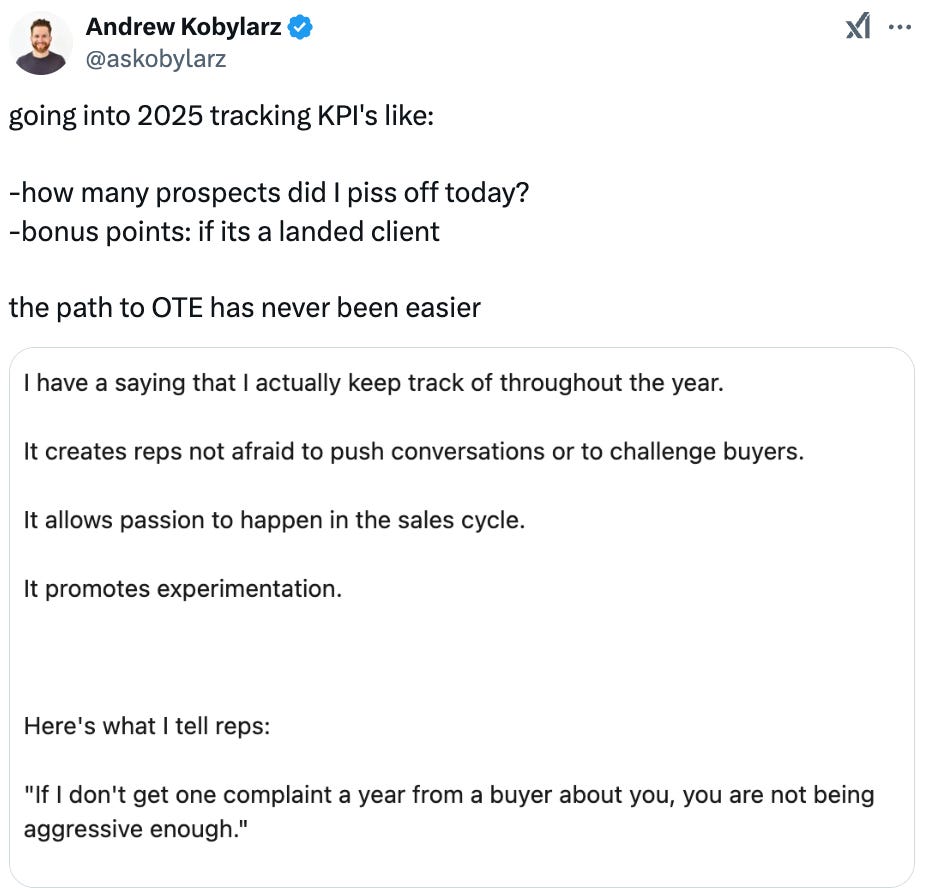3 Rules for Pleasant Persistence
Adding Friction Without Turning Prospects Off
Welcome to 2025 and Happy New Year.
Hope that everyone had a nice holiday break. Not sure about you but I’m ready to get after it after taking some time off.
Today, we’ll be covering a fun topic which we’ll break out into a 3-part series.
When is aggressive, too aggressive?
Add Friction the Right Way: 3 Rules of Thumb
Part II: Real World Breakdown: Managing Friction
Part III: Develop your POV Messaging the Right Way
What is aggressive, too aggressive?
Link
Interesting take on LinkedIn.
KPI dashboard in 2025:
Calls
Emails
Meetings
How many people did I piss off today? (better be at least one)
After reading through comments on LinkedIn, there was some back and forth that clarify what OP was going for.
My sense is that this was a tactic to push reps to dig deeper on booking meetings or discovery. Sprinkle in some good, old fashioned marketing and shock effect to juice the LinkedIn algorithm and now you’ve got everyone’s attention.
Nevertheless, it brings up an interesting question:
When is aggressive, too aggressive?
Generally, pushing for a “no” as a rep is okay. You can be be aggressive, but with tact.
You don’t want a prospect being turned off or black listing you because you were that guy. However, you do want to go as far as you can to qualify and push the deal. It’s a balance which requires EQ.
As OP puts it:
Add Friction the Right Way: 3 Rules of Thumb
My rule of thumb in scenarios where you *feel* as if you might piss off a customer/prospect:
1. context is key: have a solid "why"/ POV
2. who/what do you know: sharing information and connecting dots is useful, not intrusive
3. who have you helped? solving similar problems for other clients equals credibility
1. A Solid “Why” or Point of View
Developing a point of view shows that you’ve done your research. I’ve written about this before in learning to read your customer’s mind. From an emotional level, this also equips you with conviction.
How you deliver words is far more powerful than the words themselves.
2. Who/what do you know: Connecting Dots
If you’re able to connect the dots in an account, your touch points are invaluable. Especially in larger organizations where departments and personnel don’t have time to talk to each other and share everything that’s working - or not.
Think: understanding pain points, speaking in the customer language, or sharing successes from your product. Social proof that you have helped key stakeholders within an organization overcome obstacles.
"We had an enterprise seller selling to one of the largest corporations in the world. The reason he was able to do a $10/$20 mm deal was because he was able to go out and build bridges within divisions the company didn't even have."
-Karan Singh, Sapphire Ventures
3. Who have you helped?
This helps in really cold outreach. If you know your ICP deeply, sharing how you’ve helped other similar customer profiles - shows you understand their challenges.
Although it takes a little bit of a wider net and timing to go your way, it’s never a burden to know that you have a vendor who can help when the time comes (or if timing is in fact right).
All this to say - following these rules of thumb, whether it be outreach or during your sales cycle, you mitigate your risk of being putting off prospects by being “aggressive”. Bonus points? You’ll have conviction and confidence.
Part II: Real World Breakdown: Managing Friction (Next Post)
Next post, I’ll cover a scenario where I had been told to stop reaching out to C-suite executives within an account. I had used what I had known from bottom up conversations, and even some help from my executive team. It was enough to push the envelope just enough, but not too much.
In retrospect, I’m not even sure that this was the best approach. However, I used what I knew and most importantly, took action. In reality I had nothing to lose and it ended up being a positive outcome.
In part III, I’ll break down how to I’d do it over again now that I’ve refined the process.
Hope that these 3 rules of thumb help push to get a no, have more confidence, all while not pissing off prospects at the same time.
A little “pleasant persistence" goes a long way.
As always, thanks for reading and see you all next week. If you have any questions or thoughts, shoot me a DM or email andrew@hackingsales.xyz.
-Andrew K
PS - if you liked this article, feel free to give a “like”, “comment”, or “share” with your network.



